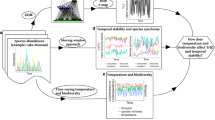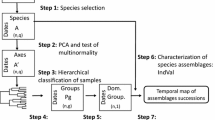Abstract
While the steady state is often seen as the final result of development in nature, a more realistic concept may be that nature pulses regularly to make a pulsing steady stata—a new paradigm gaining acceptance in ecology and many other fields. In this paper we compare tidal salt marshes, tidal freshwater marshes, and seasonally flooded fresh-water wetlands as examples of pulsed ecosystems. Despite marked differences in species composition, biodiversity, and community structure, these wetland types are functionally similar because of the common denominator of water flow pulses. Often a period of high production alternates with a period of rapid consumption in these fluctuating water-level systems, a biotic pulsing to which many life histories, such as that of the wood stork, are adapted. Pulsing of medium frequency and amplitude often provides an energy subsidy for the community thus enhancing its productivity. The energy of large-scale pulses such as storms are usually dissipated in natural ecosystems with little harm to the biotic network; however, when seawalls, dikes, or stabilized sand dunes are constructed to confront these strong pulses, the whole ecosystem (and associated human structures) may be severly damaged when the barriers fail because too much of the storm energy is concentrated on them. The relationship between biologically mediated internal pulsing, such as plant-herbivore or predator-prey cycles, and physical external pulsing is discussed not only in wetlands but in other ecosystem types as well. An intriguing hypothesis is that ecosystem performance and species survival are enhanced when external and internal pulses are coupled. We suggest that if pulsing is general, then what is sustainable in ecosystems, is a repeating oscillation that is often poised on the edge of chaos.
Similar content being viewed by others
Literature Cited
Alexander, M. 1981. Why microbial parasites and predators do not eliminate their prey and hosts.Annual Review of Microbiology 35:113–133.
Anderson, R. M. andR. M. May. 1982. Coevolution of hosts and parasites.Parasitology 85:411–426.
Birch, J. B. andJ. L. Cooley. 1983. The effect of hydroperiod on floodplain forest production. ERC 08-83. Environmental Research Center, Georgia Institute of Technology, Atlanta, Georgia.
Brown, S. 1981. A comparison of structure, primary productivity and transpiration of cypress ecosystems in Florida.Ecological Monographs 51:403–427.
Beyers, R. J. andH. T. Odum. 1983. Ecological Microcosms. Springer-Verlag, New York.
Campbell, D. E. 1984. Energy filter properties of ecosystems. Ph.D. Dissertation. Environmental Engineering Sciences, University of Florida, Gainesville, Florida.
Conner, W. H., J. B. Gosselink, andR. T. Parrondo. 1981. Comparison of vegetation of three Louisiana swamp site with different flooding regimes.American Journal of Botany 68:320–331.
Dyer, M. L., D. L. DeAngelis, andW. M. Post. 1986. A model for herbivore feedback in plant productivity.Mathematical Biosciences 79:171–184.
Gallagher, J. L., R. J. Reimold, R. A. Linthurst, andW. J. Peeffer. 1981. Aerial production, mortality, and mineral accumulation-export dynamics inSpartina alterniflora andJuncus raemerianus Plant stands.Ecology 61:303–312.
Hanski, I., P. Turchin, E. Korplamki, andH. Henttonen. 1993. Population oscillations of boreal rodents: Regulation by mustelid predators leads to chaos.Nature 364,:232–233.
Kahl, M. P. 1964. The food ecology of the wood stork.Ecological Monographs 34:97–117.
Kaufman, W. andO. H. Pilkey. 1983. The Beaches Are Moving. Duke University Press, Durham, North Carolina.
Kauffman, S. A. 1993. The Origin of Order. Oxford University Press, UK
Lotka, A. J. 1922. A contribution to the energietics of evolution.Proceedings of the National Academy of Sciences 8:140–155.
Lotka, A. J. 1925. Elements of Physical Biology. Williams & Wilkins, Baltimore, Maryland.
May, R. M. 1974. Biological populations with non-overlaping generations stable points, stable cycles, and chaos.Science 186:645–647.
Mitch, W. J. andK. C. Ewell. 1979. Comparative biomass and growth of cypress in Florida.American Midland Naturalist 101: 417–426.
Meyers, J. H. 1993. Population outbreaks in forest, lepidoptera.American Scientist 81:240–251.
Odum, E. P. 1980. The status of three ecosystem-level hypoptheses regarding salt, marsh estuaries. Tidal subsidy, outwelling and detritus based food chains. p. 485–495.In V. S. Kennedy (eds.), Estuarine Perspectives. Academic Press, New York.
Odum, E. P., J. P. Birch, andJ. L. Cooley. 1983. Comparison of giant cuttgrass productivity in tidal and impounded marshes with special reference to tidal subsidy and waste assimilation.Estuaries 6:88–94.
Odum, E. P. andM. E. Fanning. 1973. Comparison, of the productivity ofSpartina alterniflora andSpartina cynosuroides in Georgia coastal marshes.Georgia Journal of Science 31:1–12.
Odum, E. P., J. T. Finn, andE. H. Franz. 1979. Perturbation theory and the subsidy-stress gradient.BioScience 29:349–352.
Odum, H. T. 1964. Review of Keith’s Wildlife’s Ten Year Cycles.American Scientist 52:2.
Odum, H. T. 1983. Systems Ecology, John Wiley & Sons, New York.
Odum, H. T. andR. C. Pinkerton. 1955. Times speed regulator; the optimum efficiency for maximum power output in physical and biological systems.American Scientist 43:321–343.
Odum, W. E. 1988. Comparative ecology of tidal freshwater and salt marshes.Annual Review of Ecology and Systematics 19:147–176.
Odum, W. E. 1990. Internal processes influencing the maintenance of ecotones. Chapter 6In R. J. Naiman and H. Decamps (eds.), The Ecology and Management of Aquatic-Terrestrial Ecosystems. Parthenon Publishing Group, Park Ridge, New Jersey.
Odum, W. E. andM. A. Heywood, 1978. Decomposition of intertidal freshwater plants, p. 89–97.In R. E. Good, F. Whigham, and R. L. Simpson (eds.), Freshwater Wetlands, Ecological Processes and Managment Potential. Academic Press, New York.
Odum, W. E., J. S. Fisher, andJ. C. Pickeral. 1979. Factors controlling the flux of particulate carbon from estuarine wetlands, p. 69–80.In R. J. Livingston (ed.) Ecological Processes in Coastal and Marine Systems. Marrine Science Series No. 10. Plenum Publishing Corporation, New York.
Odum, W. E. andJ. K. Hoover. 1987. A comparison of vascular plant communities in tidal freshwater and salwater marshes, p. 526–534.In D. D. Hook, W. H. McKee, Jr. H. K. Smith, J. Gregory, V. G. Burrell, Jr., M. R. DeVoe, R. E. Sojka, S. Gilbert, R. Banks, L. H. Stolzy, C. Brooks, T. D. Mathews, and T. H. Shear (eds.), The Ecology and Management of Wetlands. Volume 1: Ecology of Wetlands. Timber Press, Portland, Oregon.
Odum, W. E., L. P. Rozas, andC. C. McIvor 1987a. A comparison of fish and invertebrate community composition in tidal freshwater and oligohaline marsh systems, p. 561–569.In D. D. Hook, W. H. McKee, Jr., H. K. Smith, J. Gregory, V. G. Burrell, Jr., M. R. DeVoe, R. E. Sojka, S. Gilbert, R. Banks, L. H. Stolzy, C. Brooks, T. D. Matthews, and T. H. Shear (eds). The Ecology and Management of Wetlands. Volume 1: Ecology of Wetland. Timber Press, Portland, Oregon.
Odum, W. E., T. J. Smith, andR. DoLand. 1987b. Suppression of natural disturbance: Long-term ecological change on the Outer Banks of North Carolina, p. 123–135.In M. G. Tumer (ed.), Landscape Heterogeniety and Disturbance. Ecological Studies 65, Springer-Verlag, New York.
Odum, W. E., T. J. Smith, J. K. Hoover, and C. C. Mclvor, 1984. The Ecology of Tidal Freshwater Marshes of the United States East Coast: A Community Profile., United States Fish and Wildilife Service. FWS/OBS-83/17.
Odum, W. E., J. C. Zieman, andE. J. Helad. 1972. The importance of vascular plant detritus to estuaries, p. 91–114.In R. H. Chabreck (ed.), Proceedings of the Coastal Marsh and Estuary Managment Symposium. Louisiana State University Division of Continuting Education, Baton Rouge, Louisiana.
Painting, S. J. 1989. Bacterioplankton dynamics in the southern Benguela upwelling region. Ph.D. Dissertation., University of Cape Town, South Africa.
Pomeroy, L. R. 1992. The microbial food web.Oceanus 35:28–35.
Pomeroy, L. R. andR. G. Wieget. 1982. Ecology of Salt Marsh. Ecological Studies 38. Springer-Verlag, New York.
Steever, E. Z., R. S. Warren, andW. A. Niering. 1976. Tidal energy subsidy and standing crop production ofSpartina alternifloria.Estuarine, Coastal and Marine Science 4:473–478.
Zwick, P. D. 1985. Energy systems and inertial oscillation. Ph.D. Dissertation, University of Florida, Gainesville, Florida.
Author information
Authors and Affiliations
Additional information
Naturalists-ecologists are saddened by the, untimely death of William E. Odum in April 1991.
Rights and permissions
About this article
Cite this article
Odum, W.E., Odum, E.P. & Odum, H.T. Nature’s pulsing paradigm. Estuaries 18, 547–555 (1995). https://doi.org/10.2307/1352375
Received:
Accepted:
Issue Date:
DOI: https://doi.org/10.2307/1352375




